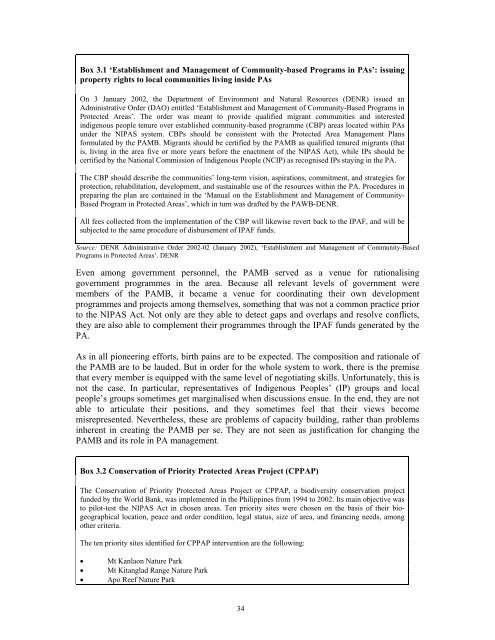Developing pro-poor markets for environmental services in the ...
Developing pro-poor markets for environmental services in the ...
Developing pro-poor markets for environmental services in the ...
Create successful ePaper yourself
Turn your PDF publications into a flip-book with our unique Google optimized e-Paper software.
Box 3.1 ‘Establishment and Management of Community-based Programs <strong>in</strong> PAs’: issu<strong>in</strong>g<br />
<strong>pro</strong>perty rights to local communities liv<strong>in</strong>g <strong>in</strong>side PAs<br />
On 3 January 2002, <strong>the</strong> Department of Environment and Natural Resources (DENR) issued an<br />
Adm<strong>in</strong>istrative Order (DAO) entitled ‘Establishment and Management of Community-Based Programs <strong>in</strong><br />
Protected Areas’. The order was meant to <strong>pro</strong>vide qualified migrant communities and <strong>in</strong>terested<br />
<strong>in</strong>digenous people tenure over established community-based <strong>pro</strong>gramme (CBP) areas located with<strong>in</strong> PAs<br />
under <strong>the</strong> NIPAS system. CBPs should be consistent with <strong>the</strong> Protected Area Management Plans<br />
<strong>for</strong>mulated by <strong>the</strong> PAMB. Migrants should be certified by <strong>the</strong> PAMB as qualified tenured migrants (that<br />
is, liv<strong>in</strong>g <strong>in</strong> <strong>the</strong> area five or more years be<strong>for</strong>e <strong>the</strong> enactment of <strong>the</strong> NIPAS Act), while IPs should be<br />
certified by <strong>the</strong> National Commission of Indigenous People (NCIP) as recognised IPs stay<strong>in</strong>g <strong>in</strong> <strong>the</strong> PA.<br />
The CBP should describe <strong>the</strong> communities’ long-term vision, aspirations, commitment, and strategies <strong>for</strong><br />
<strong>pro</strong>tection, rehabilitation, development, and susta<strong>in</strong>able use of <strong>the</strong> resources with<strong>in</strong> <strong>the</strong> PA. Procedures <strong>in</strong><br />
prepar<strong>in</strong>g <strong>the</strong> plan are conta<strong>in</strong>ed <strong>in</strong> <strong>the</strong> ‘Manual on <strong>the</strong> Establishment and Management of Community-<br />
Based Program <strong>in</strong> Protected Areas’, which <strong>in</strong> turn was drafted by <strong>the</strong> PAWB-DENR.<br />
All fees collected from <strong>the</strong> implementation of <strong>the</strong> CBP will likewise revert back to <strong>the</strong> IPAF, and will be<br />
subjected to <strong>the</strong> same <strong>pro</strong>cedure of disbursement of IPAF funds.<br />
Source: DENR Adm<strong>in</strong>istrative Order 2002-02 (January 2002), ‘Establishment and Management of Community-Based<br />
Programs <strong>in</strong> Protected Areas’. DENR<br />
Even among government personnel, <strong>the</strong> PAMB served as a venue <strong>for</strong> rationalis<strong>in</strong>g<br />
government <strong>pro</strong>grammes <strong>in</strong> <strong>the</strong> area. Because all relevant levels of government were<br />
members of <strong>the</strong> PAMB, it became a venue <strong>for</strong> coord<strong>in</strong>at<strong>in</strong>g <strong>the</strong>ir own development<br />
<strong>pro</strong>grammes and <strong>pro</strong>jects among <strong>the</strong>mselves, someth<strong>in</strong>g that was not a common practice prior<br />
to <strong>the</strong> NIPAS Act. Not only are <strong>the</strong>y able to detect gaps and overlaps and resolve conflicts,<br />
<strong>the</strong>y are also able to complement <strong>the</strong>ir <strong>pro</strong>grammes through <strong>the</strong> IPAF funds generated by <strong>the</strong><br />
PA.<br />
As <strong>in</strong> all pioneer<strong>in</strong>g ef<strong>for</strong>ts, birth pa<strong>in</strong>s are to be expected. The composition and rationale of<br />
<strong>the</strong> PAMB are to be lauded. But <strong>in</strong> order <strong>for</strong> <strong>the</strong> whole system to work, <strong>the</strong>re is <strong>the</strong> premise<br />
that every member is equipped with <strong>the</strong> same level of negotiat<strong>in</strong>g skills. Un<strong>for</strong>tunately, this is<br />
not <strong>the</strong> case. In particular, representatives of Indigenous Peoples’ (IP) groups and local<br />
people’s groups sometimes get marg<strong>in</strong>alised when discussions ensue. In <strong>the</strong> end, <strong>the</strong>y are not<br />
able to articulate <strong>the</strong>ir positions, and <strong>the</strong>y sometimes feel that <strong>the</strong>ir views become<br />
misrepresented. Never<strong>the</strong>less, <strong>the</strong>se are <strong>pro</strong>blems of capacity build<strong>in</strong>g, ra<strong>the</strong>r than <strong>pro</strong>blems<br />
<strong>in</strong>herent <strong>in</strong> creat<strong>in</strong>g <strong>the</strong> PAMB per se. They are not seen as justification <strong>for</strong> chang<strong>in</strong>g <strong>the</strong><br />
PAMB and its role <strong>in</strong> PA management.<br />
Box 3.2 Conservation of Priority Protected Areas Project (CPPAP)<br />
The Conservation of Priority Protected Areas Project or CPPAP, a biodiversity conservation <strong>pro</strong>ject<br />
funded by <strong>the</strong> World Bank, was implemented <strong>in</strong> <strong>the</strong> Philipp<strong>in</strong>es from 1994 to 2002. Its ma<strong>in</strong> objective was<br />
to pilot-test <strong>the</strong> NIPAS Act <strong>in</strong> chosen areas. Ten priority sites were chosen on <strong>the</strong> basis of <strong>the</strong>ir biogeographical<br />
location, peace and order condition, legal status, size of area, and f<strong>in</strong>anc<strong>in</strong>g needs, among<br />
o<strong>the</strong>r criteria.<br />
The ten priority sites identified <strong>for</strong> CPPAP <strong>in</strong>tervention are <strong>the</strong> follow<strong>in</strong>g:<br />
• Mt Kanlaon Nature Park<br />
• Mt Kitanglad Range Nature Park<br />
• Apo Reef Nature Park<br />
34
















